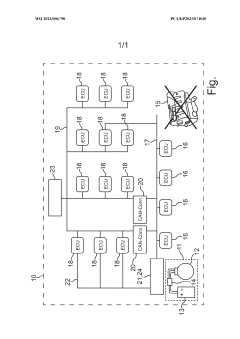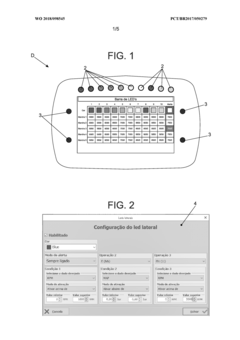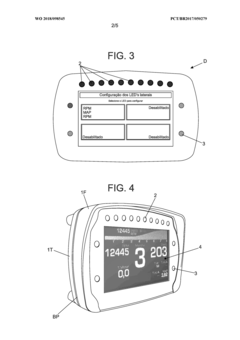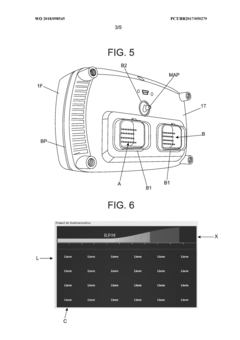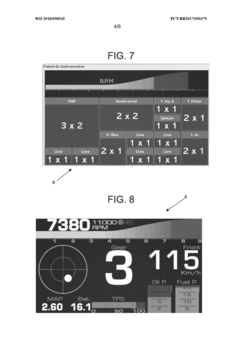How to Integrate Modern Electronics into K24 Engine Systems?
JUL 3, 20259 MIN READ
Generate Your Research Report Instantly with AI Agent
Patsnap Eureka helps you evaluate technical feasibility & market potential.
K24 Engine Electronics Integration Background
The K24 engine, developed by Honda, has been a cornerstone in the automotive industry since its introduction in the early 2000s. Known for its reliability and performance, this 2.4-liter inline-four engine has powered various Honda and Acura models. As automotive technology has advanced, the integration of modern electronics into the K24 engine system has become increasingly important to meet evolving performance, efficiency, and emissions standards.
The evolution of engine management systems has played a crucial role in enhancing the K24's capabilities. Initially, the K24 utilized relatively simple electronic control units (ECUs) that managed basic functions such as fuel injection and ignition timing. However, as emissions regulations tightened and consumer demands for improved fuel economy and performance increased, more sophisticated electronic systems were gradually incorporated.
One of the key advancements in K24 engine electronics was the introduction of drive-by-wire throttle control. This technology replaced the traditional mechanical linkage between the accelerator pedal and the throttle body with electronic sensors and actuators, allowing for more precise control of engine performance and improved fuel efficiency.
Variable valve timing and lift electronic control (VTEC) systems, a hallmark of Honda engines, also saw significant improvements through electronic integration. The K24's i-VTEC system, which combines VTEC with variable timing control (VTC), relies heavily on electronic sensors and actuators to optimize valve timing and lift across a wide range of engine speeds and loads.
As emissions standards became more stringent, electronic systems played a crucial role in meeting these requirements. Advanced oxygen sensors, electronic exhaust gas recirculation (EGR) systems, and more sophisticated catalytic converters were integrated into the K24 platform, all controlled and monitored by increasingly powerful ECUs.
The advent of direct fuel injection technology in later iterations of the K24 engine further highlighted the importance of electronic integration. This system requires precise control of fuel pressure and injection timing, which is only possible through advanced electronic management systems.
In recent years, the push for hybridization has led to even more complex electronic integration in K24-based powertrains. Honda's Integrated Motor Assist (IMA) system, which pairs an electric motor with the K24 engine in some models, requires sophisticated electronic control to manage the interplay between the gasoline engine and electric motor.
As we look towards the future of K24 engine systems, the integration of modern electronics continues to be a critical factor in meeting performance, efficiency, and emissions goals. The challenge lies in seamlessly incorporating these advanced electronic systems while maintaining the reliability and simplicity that have made the K24 engine so popular among enthusiasts and everyday drivers alike.
The evolution of engine management systems has played a crucial role in enhancing the K24's capabilities. Initially, the K24 utilized relatively simple electronic control units (ECUs) that managed basic functions such as fuel injection and ignition timing. However, as emissions regulations tightened and consumer demands for improved fuel economy and performance increased, more sophisticated electronic systems were gradually incorporated.
One of the key advancements in K24 engine electronics was the introduction of drive-by-wire throttle control. This technology replaced the traditional mechanical linkage between the accelerator pedal and the throttle body with electronic sensors and actuators, allowing for more precise control of engine performance and improved fuel efficiency.
Variable valve timing and lift electronic control (VTEC) systems, a hallmark of Honda engines, also saw significant improvements through electronic integration. The K24's i-VTEC system, which combines VTEC with variable timing control (VTC), relies heavily on electronic sensors and actuators to optimize valve timing and lift across a wide range of engine speeds and loads.
As emissions standards became more stringent, electronic systems played a crucial role in meeting these requirements. Advanced oxygen sensors, electronic exhaust gas recirculation (EGR) systems, and more sophisticated catalytic converters were integrated into the K24 platform, all controlled and monitored by increasingly powerful ECUs.
The advent of direct fuel injection technology in later iterations of the K24 engine further highlighted the importance of electronic integration. This system requires precise control of fuel pressure and injection timing, which is only possible through advanced electronic management systems.
In recent years, the push for hybridization has led to even more complex electronic integration in K24-based powertrains. Honda's Integrated Motor Assist (IMA) system, which pairs an electric motor with the K24 engine in some models, requires sophisticated electronic control to manage the interplay between the gasoline engine and electric motor.
As we look towards the future of K24 engine systems, the integration of modern electronics continues to be a critical factor in meeting performance, efficiency, and emissions goals. The challenge lies in seamlessly incorporating these advanced electronic systems while maintaining the reliability and simplicity that have made the K24 engine so popular among enthusiasts and everyday drivers alike.
Market Demand Analysis
The integration of modern electronics into K24 engine systems has seen a significant surge in market demand, driven by the automotive industry's push towards more efficient, intelligent, and connected vehicles. This trend is particularly evident in the performance and aftermarket sectors, where enthusiasts and tuners seek to enhance the capabilities of the popular K24 engine platform.
The market for electronically enhanced K24 engine systems has expanded rapidly, with a growing number of consumers seeking improved performance, fuel efficiency, and advanced diagnostics. This demand is fueled by the increasing sophistication of car buyers who expect their vehicles to offer not just mechanical prowess but also cutting-edge electronic features.
In the performance segment, there is a strong appetite for electronic control units (ECUs) that can be easily programmed to optimize engine output. Tuners and performance shops are looking for solutions that allow for real-time adjustments to fuel mapping, ignition timing, and boost control in turbocharged applications. This has created a niche market for aftermarket ECUs and piggyback systems specifically designed for the K24 engine.
The demand for integrated telematics and connectivity solutions in K24-equipped vehicles is also on the rise. Consumers are increasingly interested in features such as remote engine monitoring, performance data logging, and smartphone integration. This trend aligns with the broader automotive industry's move towards connected car technologies and the Internet of Things (IoT).
Environmental regulations and fuel efficiency standards have further stimulated the market for electronically controlled engine management systems. As emissions requirements become more stringent, there is a growing need for sophisticated electronic systems that can precisely control fuel injection and exhaust gas recirculation to meet these standards while maintaining performance.
The aftermarket sector has seen a proliferation of plug-and-play electronic upgrades for K24 engines, catering to DIY enthusiasts who want to enhance their vehicles without extensive mechanical modifications. This has opened up new market opportunities for manufacturers of bolt-on electronic components and tuning solutions.
Fleet operators and commercial users of K24-powered vehicles are also driving demand for integrated electronics, particularly for features that enhance fleet management, such as real-time engine health monitoring and predictive maintenance capabilities. This segment of the market values solutions that can improve operational efficiency and reduce downtime.
As the automotive industry continues its transition towards electrification, there is an emerging market for hybrid solutions that integrate modern electronics with the K24 engine platform. This includes mild hybrid systems and start-stop technology, which require sophisticated electronic integration to work seamlessly with the existing engine architecture.
The market analysis indicates a clear trend towards more comprehensive electronic integration in K24 engine systems, with consumers and businesses alike seeking solutions that offer enhanced performance, efficiency, and connectivity. This demand is expected to continue growing as technology advances and as the automotive industry evolves towards more electronically controlled and connected vehicles.
The market for electronically enhanced K24 engine systems has expanded rapidly, with a growing number of consumers seeking improved performance, fuel efficiency, and advanced diagnostics. This demand is fueled by the increasing sophistication of car buyers who expect their vehicles to offer not just mechanical prowess but also cutting-edge electronic features.
In the performance segment, there is a strong appetite for electronic control units (ECUs) that can be easily programmed to optimize engine output. Tuners and performance shops are looking for solutions that allow for real-time adjustments to fuel mapping, ignition timing, and boost control in turbocharged applications. This has created a niche market for aftermarket ECUs and piggyback systems specifically designed for the K24 engine.
The demand for integrated telematics and connectivity solutions in K24-equipped vehicles is also on the rise. Consumers are increasingly interested in features such as remote engine monitoring, performance data logging, and smartphone integration. This trend aligns with the broader automotive industry's move towards connected car technologies and the Internet of Things (IoT).
Environmental regulations and fuel efficiency standards have further stimulated the market for electronically controlled engine management systems. As emissions requirements become more stringent, there is a growing need for sophisticated electronic systems that can precisely control fuel injection and exhaust gas recirculation to meet these standards while maintaining performance.
The aftermarket sector has seen a proliferation of plug-and-play electronic upgrades for K24 engines, catering to DIY enthusiasts who want to enhance their vehicles without extensive mechanical modifications. This has opened up new market opportunities for manufacturers of bolt-on electronic components and tuning solutions.
Fleet operators and commercial users of K24-powered vehicles are also driving demand for integrated electronics, particularly for features that enhance fleet management, such as real-time engine health monitoring and predictive maintenance capabilities. This segment of the market values solutions that can improve operational efficiency and reduce downtime.
As the automotive industry continues its transition towards electrification, there is an emerging market for hybrid solutions that integrate modern electronics with the K24 engine platform. This includes mild hybrid systems and start-stop technology, which require sophisticated electronic integration to work seamlessly with the existing engine architecture.
The market analysis indicates a clear trend towards more comprehensive electronic integration in K24 engine systems, with consumers and businesses alike seeking solutions that offer enhanced performance, efficiency, and connectivity. This demand is expected to continue growing as technology advances and as the automotive industry evolves towards more electronically controlled and connected vehicles.
Current Challenges in K24 Engine Electronics
The integration of modern electronics into K24 engine systems presents several significant challenges. One of the primary obstacles is the need for seamless compatibility between new electronic components and the existing mechanical structure of the K24 engine. This requires careful consideration of space constraints, heat management, and vibration resistance within the engine compartment.
Another major challenge lies in the development of robust and reliable software systems to control and optimize the electronic components. The software must be capable of real-time processing and decision-making, while also being adaptable to various driving conditions and user preferences. This necessitates advanced algorithms and sophisticated control systems that can handle the complex interactions between different engine subsystems.
The issue of electromagnetic interference (EMI) also poses a significant hurdle. As more electronic components are introduced into the engine system, the potential for EMI increases, which can lead to malfunctions or degraded performance. Shielding and isolation techniques must be employed to ensure the reliable operation of all electronic systems within the engine environment.
Power management and energy efficiency present another set of challenges. The integration of additional electronic systems increases the overall power demand on the engine's electrical system. This requires careful design of power distribution networks and the potential incorporation of more efficient alternators or even mild hybrid systems to meet the increased energy requirements without compromising engine performance.
Durability and longevity of electronic components in the harsh engine environment are also critical concerns. Electronic systems must withstand extreme temperatures, vibrations, and exposure to various fluids and contaminants. This necessitates the use of ruggedized components and protective enclosures, which can add complexity and cost to the overall system.
The challenge of backward compatibility and serviceability cannot be overlooked. As new electronic systems are integrated, it is crucial to ensure that they can be easily diagnosed, repaired, or replaced without requiring extensive modifications to the existing engine structure. This is particularly important for maintaining the longevity and value of K24-equipped vehicles already in the market.
Lastly, the cost-effectiveness of integrating advanced electronics into the K24 engine system remains a significant challenge. Balancing the benefits of improved performance, efficiency, and features against the increased production costs is crucial for maintaining the competitiveness of K24-powered vehicles in the market. This requires careful consideration of component selection, manufacturing processes, and overall system design to optimize the cost-benefit ratio of electronic integration.
Another major challenge lies in the development of robust and reliable software systems to control and optimize the electronic components. The software must be capable of real-time processing and decision-making, while also being adaptable to various driving conditions and user preferences. This necessitates advanced algorithms and sophisticated control systems that can handle the complex interactions between different engine subsystems.
The issue of electromagnetic interference (EMI) also poses a significant hurdle. As more electronic components are introduced into the engine system, the potential for EMI increases, which can lead to malfunctions or degraded performance. Shielding and isolation techniques must be employed to ensure the reliable operation of all electronic systems within the engine environment.
Power management and energy efficiency present another set of challenges. The integration of additional electronic systems increases the overall power demand on the engine's electrical system. This requires careful design of power distribution networks and the potential incorporation of more efficient alternators or even mild hybrid systems to meet the increased energy requirements without compromising engine performance.
Durability and longevity of electronic components in the harsh engine environment are also critical concerns. Electronic systems must withstand extreme temperatures, vibrations, and exposure to various fluids and contaminants. This necessitates the use of ruggedized components and protective enclosures, which can add complexity and cost to the overall system.
The challenge of backward compatibility and serviceability cannot be overlooked. As new electronic systems are integrated, it is crucial to ensure that they can be easily diagnosed, repaired, or replaced without requiring extensive modifications to the existing engine structure. This is particularly important for maintaining the longevity and value of K24-equipped vehicles already in the market.
Lastly, the cost-effectiveness of integrating advanced electronics into the K24 engine system remains a significant challenge. Balancing the benefits of improved performance, efficiency, and features against the increased production costs is crucial for maintaining the competitiveness of K24-powered vehicles in the market. This requires careful consideration of component selection, manufacturing processes, and overall system design to optimize the cost-benefit ratio of electronic integration.
Existing K24 Electronics Solutions
01 Engine control and management systems
Advanced control systems for K24 engines, including electronic control units (ECUs) and sensors, to optimize performance, fuel efficiency, and emissions. These systems monitor and adjust various engine parameters in real-time, such as fuel injection, ignition timing, and valve timing.- Engine control and management systems: Advanced control systems for K24 engines, including electronic control units (ECUs) and sensors, to optimize performance, fuel efficiency, and emissions. These systems monitor and adjust various engine parameters in real-time, ensuring optimal operation under different conditions.
- Fuel injection and combustion optimization: Innovative fuel injection systems and combustion chamber designs for K24 engines to improve fuel atomization, mixture formation, and combustion efficiency. These advancements contribute to increased power output, reduced fuel consumption, and lower emissions.
- Turbocharging and forced induction: Integration of turbocharging and other forced induction technologies in K24 engine systems to boost power output and torque. These systems may include variable geometry turbochargers, intercoolers, and advanced boost control mechanisms to enhance engine performance across a wide range of operating conditions.
- Valve timing and lift control: Variable valve timing and lift control systems for K24 engines to optimize airflow and combustion characteristics. These technologies allow for dynamic adjustment of valve operation based on engine speed, load, and other factors, resulting in improved performance, fuel efficiency, and emissions control.
- Engine diagnostics and monitoring: Advanced diagnostic and monitoring systems for K24 engines, including onboard diagnostics (OBD) and real-time performance tracking. These systems help identify potential issues, optimize maintenance schedules, and provide valuable data for engine performance analysis and improvement.
02 Fuel injection and combustion optimization
Innovative fuel injection technologies and combustion chamber designs specific to K24 engines, aimed at improving fuel atomization, mixture formation, and combustion efficiency. These advancements contribute to enhanced power output, reduced emissions, and better fuel economy.Expand Specific Solutions03 Variable valve timing and lift systems
Implementation of variable valve timing and lift mechanisms in K24 engines to optimize engine breathing across different operating conditions. These systems allow for improved low-end torque, high-end power, and overall engine efficiency by adjusting valve timing and lift based on engine speed and load.Expand Specific Solutions04 Turbocharging and forced induction
Integration of turbocharging or other forced induction systems with K24 engines to increase power output and torque while maintaining or improving fuel efficiency. This includes advanced turbocharger designs, intercooling systems, and electronic boost control mechanisms tailored for K24 engine applications.Expand Specific Solutions05 Engine cooling and thermal management
Specialized cooling systems and thermal management solutions for K24 engines, including advanced radiator designs, electric water pumps, and intelligent cooling control strategies. These systems aim to maintain optimal engine operating temperatures, improve efficiency, and enhance overall engine longevity.Expand Specific Solutions
Key Players in Automotive Electronics
The integration of modern electronics into K24 engine systems represents a competitive landscape in a mature yet evolving industry. The market is characterized by established players like Robert Bosch GmbH, ZF Friedrichshafen AG, and Honda Motor Co., Ltd., who are investing heavily in advanced electronic solutions for engine management. The market size is substantial, driven by the automotive industry's shift towards more efficient and intelligent powertrains. Technologically, companies like BorgWarner, Inc. and Mercedes-Benz Group AG are pushing the boundaries with innovations in electronic control units, sensors, and connectivity features, indicating a high level of technological maturity but with ongoing advancements in areas such as electrification and software integration.
Robert Bosch GmbH
Technical Solution: Bosch has developed advanced electronic control units (ECUs) specifically designed for integration with K24 engine systems. Their solution incorporates high-performance microcontrollers and sophisticated software algorithms to optimize engine performance, fuel efficiency, and emissions control. The ECU utilizes real-time sensor data to adjust fuel injection timing, ignition timing, and valve control with millisecond precision[1]. Bosch's system also features adaptive learning capabilities, allowing it to fine-tune engine parameters based on driving conditions and habits over time[3]. Additionally, their ECU supports over-the-air updates, enabling continuous improvement and new feature deployment without hardware changes[5].
Strengths: Industry-leading expertise in automotive electronics, extensive R&D resources, and a strong track record of innovation. Weaknesses: Higher cost compared to some competitors, potential complexity in implementation for smaller manufacturers.
Honda Motor Co., Ltd.
Technical Solution: Honda has developed a proprietary electronic integration system for their K24 engines, focusing on seamless communication between engine components and vehicle systems. Their approach utilizes a centralized ECU that coordinates with multiple sub-modules, each dedicated to specific engine functions such as fuel management, ignition control, and emissions systems[2]. Honda's system incorporates advanced sensor technology, including wide-band oxygen sensors and knock sensors, to provide precise feedback for engine optimization[4]. The integration also extends to the transmission control unit, allowing for smoother gear shifts and improved overall drivetrain efficiency. Honda's solution includes a sophisticated onboard diagnostic system that can detect and report potential issues before they become critical[6].
Strengths: Deep understanding of K24 engine architecture, proven reliability in real-world applications, and strong integration with other vehicle systems. Weaknesses: Potentially less flexible for third-party modifications or aftermarket upgrades.
Core Innovations in Engine ECUs
Electronic conversion kit for a motor vehicle, in which an internal combustion engine is exchanged for an electric traction drive having an electric motor, motor vehicle having the conversion kit and operating method for the conversion kit
PatentWO2023006798A1
Innovation
- An electronic conversion kit that includes a bus module with a processor circuit to translate signals between existing and new bus systems, simulating missing components of the internal combustion engine to ensure continued functionality of vehicle systems, such as engine control units, and adapting accelerator pedal signals and other essential inputs for the electric traction drive.
Programmable electronic injection with integrated instrument panel and touch-screen editing
PatentWO2018098545A1
Innovation
- A programmable electronic device with an integrated instrument panel and touch screen editing capabilities, allowing direct control of engines, fuel injection, and ignition timing, along with data visualization and configuration, all in a single unit, reducing complexity and enhancing integration and usability.
Emissions Regulations Impact
The integration of modern electronics into K24 engine systems is significantly influenced by increasingly stringent emissions regulations worldwide. These regulations, aimed at reducing harmful pollutants and greenhouse gas emissions, have become a driving force for technological advancements in engine management and control systems.
In recent years, regulatory bodies such as the Environmental Protection Agency (EPA) in the United States and the European Union's Euro standards have implemented progressively tighter limits on vehicle emissions. These regulations have necessitated the development of more sophisticated electronic control units (ECUs) and sensors to monitor and optimize engine performance in real-time.
The K24 engine, originally designed with relatively basic electronic systems, now faces the challenge of meeting these stricter emissions standards. To comply with current and future regulations, manufacturers must incorporate advanced electronic components that can precisely control fuel injection, ignition timing, and exhaust gas recirculation (EGR) systems.
One of the key areas of focus is the implementation of more accurate oxygen sensors and wide-band lambda sensors. These sensors provide crucial feedback to the ECU, allowing for precise adjustments to the air-fuel mixture. This level of control is essential for maintaining optimal combustion efficiency and minimizing emissions across various operating conditions.
Additionally, the integration of variable valve timing (VVT) systems, controlled by sophisticated electronic actuators, has become necessary to meet emissions targets. These systems allow for dynamic adjustment of valve timing, improving fuel economy and reducing emissions without sacrificing performance.
The adoption of direct injection technology, facilitated by high-precision electronic injectors and advanced fuel pressure control systems, has also been driven by emissions regulations. This technology enables more efficient fuel atomization and combustion, resulting in reduced fuel consumption and lower emissions of particulate matter and nitrogen oxides.
Furthermore, emissions regulations have spurred the development of more complex aftertreatment systems, such as catalytic converters and particulate filters. These systems require sophisticated electronic monitoring and control to ensure optimal performance and longevity, adding another layer of complexity to the K24 engine's electronic architecture.
As regulations continue to evolve, the integration of modern electronics into K24 engine systems must also anticipate future requirements. This includes the potential for on-board diagnostics (OBD) systems with enhanced capabilities to detect and report emissions-related malfunctions, as well as the integration of connectivity features that could enable over-the-air updates to emissions control strategies.
In recent years, regulatory bodies such as the Environmental Protection Agency (EPA) in the United States and the European Union's Euro standards have implemented progressively tighter limits on vehicle emissions. These regulations have necessitated the development of more sophisticated electronic control units (ECUs) and sensors to monitor and optimize engine performance in real-time.
The K24 engine, originally designed with relatively basic electronic systems, now faces the challenge of meeting these stricter emissions standards. To comply with current and future regulations, manufacturers must incorporate advanced electronic components that can precisely control fuel injection, ignition timing, and exhaust gas recirculation (EGR) systems.
One of the key areas of focus is the implementation of more accurate oxygen sensors and wide-band lambda sensors. These sensors provide crucial feedback to the ECU, allowing for precise adjustments to the air-fuel mixture. This level of control is essential for maintaining optimal combustion efficiency and minimizing emissions across various operating conditions.
Additionally, the integration of variable valve timing (VVT) systems, controlled by sophisticated electronic actuators, has become necessary to meet emissions targets. These systems allow for dynamic adjustment of valve timing, improving fuel economy and reducing emissions without sacrificing performance.
The adoption of direct injection technology, facilitated by high-precision electronic injectors and advanced fuel pressure control systems, has also been driven by emissions regulations. This technology enables more efficient fuel atomization and combustion, resulting in reduced fuel consumption and lower emissions of particulate matter and nitrogen oxides.
Furthermore, emissions regulations have spurred the development of more complex aftertreatment systems, such as catalytic converters and particulate filters. These systems require sophisticated electronic monitoring and control to ensure optimal performance and longevity, adding another layer of complexity to the K24 engine's electronic architecture.
As regulations continue to evolve, the integration of modern electronics into K24 engine systems must also anticipate future requirements. This includes the potential for on-board diagnostics (OBD) systems with enhanced capabilities to detect and report emissions-related malfunctions, as well as the integration of connectivity features that could enable over-the-air updates to emissions control strategies.
Cybersecurity in Automotive Electronics
As the integration of modern electronics into automotive systems continues to advance, cybersecurity has become a critical concern in the automotive industry, particularly for systems like the K24 engine. The increasing connectivity and complexity of electronic components in vehicles have created new vulnerabilities that malicious actors could potentially exploit.
Automotive cybersecurity focuses on protecting electronic systems, networks, and data within vehicles from unauthorized access, manipulation, and attacks. For the K24 engine system, this involves safeguarding various electronic control units (ECUs), sensors, and communication networks that manage engine performance, fuel efficiency, and emissions control.
One of the primary challenges in automotive cybersecurity is the need to protect against a wide range of potential threats. These can include remote hacking attempts, malware infections, and physical tampering with vehicle systems. As K24 engine systems become more sophisticated and interconnected, the attack surface expands, necessitating comprehensive security measures.
To address these challenges, automotive manufacturers and suppliers are implementing multi-layered security approaches. This includes secure boot processes for ECUs, encrypted communication protocols between vehicle components, and intrusion detection systems. For the K24 engine, this might involve securing the engine control module (ECM) and its communications with other vehicle systems.
Another crucial aspect of cybersecurity in automotive electronics is the implementation of over-the-air (OTA) update capabilities. This allows manufacturers to quickly address security vulnerabilities and deploy patches to vehicle systems, including those in the K24 engine. However, the OTA update process itself must be secured to prevent it from becoming a potential attack vector.
As regulations around automotive cybersecurity continue to evolve, manufacturers must also ensure compliance with standards such as ISO/SAE 21434. This standard provides a framework for cybersecurity risk management throughout the vehicle lifecycle, from design and development to production and maintenance.
Looking ahead, the integration of artificial intelligence and machine learning into automotive cybersecurity systems holds promise for enhancing threat detection and response capabilities. These technologies could help identify and mitigate potential security risks in K24 engine systems more effectively and in real-time.
Automotive cybersecurity focuses on protecting electronic systems, networks, and data within vehicles from unauthorized access, manipulation, and attacks. For the K24 engine system, this involves safeguarding various electronic control units (ECUs), sensors, and communication networks that manage engine performance, fuel efficiency, and emissions control.
One of the primary challenges in automotive cybersecurity is the need to protect against a wide range of potential threats. These can include remote hacking attempts, malware infections, and physical tampering with vehicle systems. As K24 engine systems become more sophisticated and interconnected, the attack surface expands, necessitating comprehensive security measures.
To address these challenges, automotive manufacturers and suppliers are implementing multi-layered security approaches. This includes secure boot processes for ECUs, encrypted communication protocols between vehicle components, and intrusion detection systems. For the K24 engine, this might involve securing the engine control module (ECM) and its communications with other vehicle systems.
Another crucial aspect of cybersecurity in automotive electronics is the implementation of over-the-air (OTA) update capabilities. This allows manufacturers to quickly address security vulnerabilities and deploy patches to vehicle systems, including those in the K24 engine. However, the OTA update process itself must be secured to prevent it from becoming a potential attack vector.
As regulations around automotive cybersecurity continue to evolve, manufacturers must also ensure compliance with standards such as ISO/SAE 21434. This standard provides a framework for cybersecurity risk management throughout the vehicle lifecycle, from design and development to production and maintenance.
Looking ahead, the integration of artificial intelligence and machine learning into automotive cybersecurity systems holds promise for enhancing threat detection and response capabilities. These technologies could help identify and mitigate potential security risks in K24 engine systems more effectively and in real-time.
Unlock deeper insights with Patsnap Eureka Quick Research — get a full tech report to explore trends and direct your research. Try now!
Generate Your Research Report Instantly with AI Agent
Supercharge your innovation with Patsnap Eureka AI Agent Platform!
